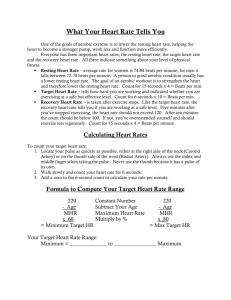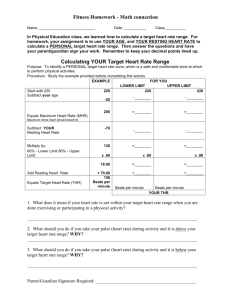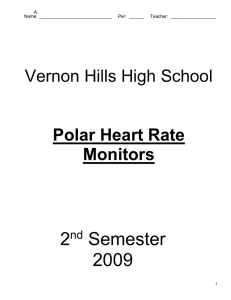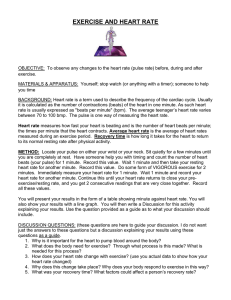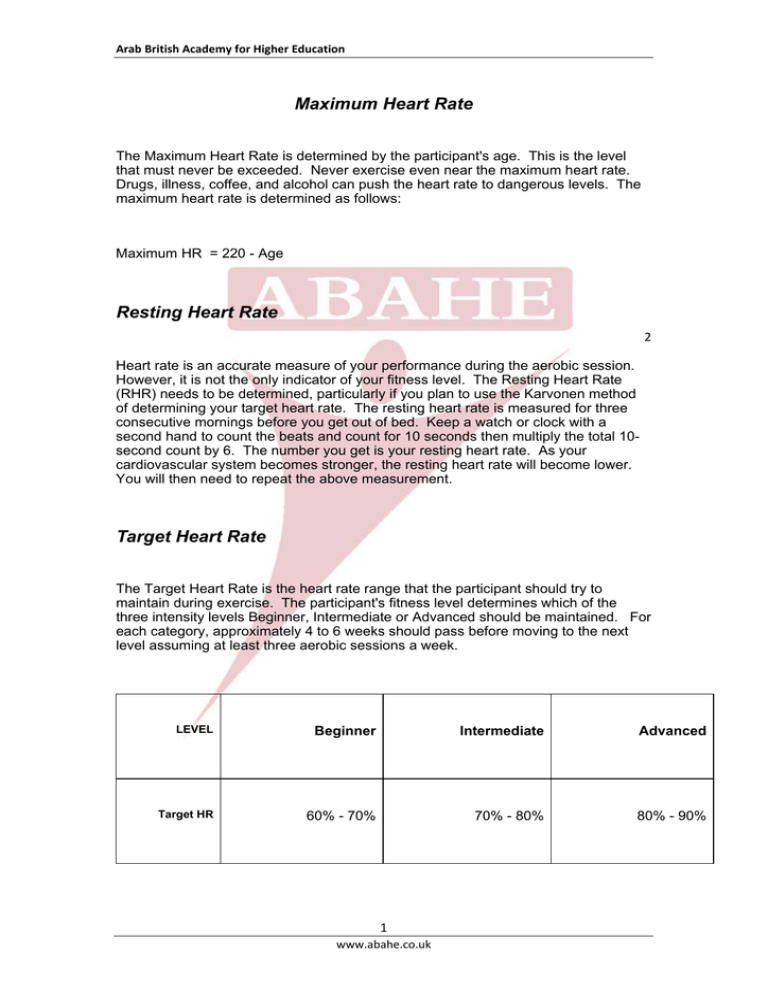
Arab British Academy for Higher Education Maximum Heart Rate
The Maximum Heart Rate is determined by the participant's age. This is the level
that must never be exceeded. Never exercise even near the maximum heart rate.
Drugs, illness, coffee, and alcohol can push the heart rate to dangerous levels. The
maximum heart rate is determined as follows:
Maximum HR = 220 - Age
Resting Heart Rate
2
Heart rate is an accurate measure of your performance during the aerobic session.
However, it is not the only indicator of your fitness level. The Resting Heart Rate
(RHR) needs to be determined, particularly if you plan to use the Karvonen method
of determining your target heart rate. The resting heart rate is measured for three
consecutive mornings before you get out of bed. Keep a watch or clock with a
second hand to count the beats and count for 10 seconds then multiply the total 10second count by 6. The number you get is your resting heart rate. As your
cardiovascular system becomes stronger, the resting heart rate will become lower.
You will then need to repeat the above measurement.
Target Heart Rate
The Target Heart Rate is the heart rate range that the participant should try to
maintain during exercise. The participant's fitness level determines which of the
three intensity levels Beginner, Intermediate or Advanced should be maintained. For
each category, approximately 4 to 6 weeks should pass before moving to the next
level assuming at least three aerobic sessions a week.
LEVEL
Beginner
Intermediate
Advanced
Target HR
60% - 70%
70% - 80%
80% - 90%
1 www.abahe.co.uk Arab British Academy for Higher Education Heart rate should be measured every 15 to 20 minutes for experienced participants
of aerobic exercise and every 5 - 10 minutes for beginners. Pulse rate can be
measured from one of two anatomical sites, the carotid artery or the anterior wrist.
Counting should begin within 5 seconds after exercise stops and begin with zero.
Count the number of beats for 10 seconds then multiply by six to get the beats per
minute. Beta-Blocker medication lowers the overall heart rate. Raising the arms
overhead produces a higher heart rate known as the Pressor response. If the heart
rate is too low, use full range of motion and more arm movement. Conversely, if the
heart rate is too high, shorten the range of motion and reduce or eliminate arm
movement. During pregnancy, heart rates should not exceed 140 bpm.
There are two methods for calculation of the target heart rate. The Standard Method
is the quick method and uses an intensity range of 60% to 90% of the maximum
heart rate. The Karvonen method incorporates the individuals resting heart rate and
is therefore the more accurate method. This method uses an intensity range of 50%
to 85%.
An example calculation using the Standard Method for a 40 year old for a desired
aerobic intensity of 75% would be:
Standard Target HR
= %Intensity/100 * (Maximum HR)
= 0.75 * (220 - 40)
= 135
An example calculation using the Karvonen Method for a 40 year old with a resting
heart rate of 50 bpm for a desired aerobic intensity of 75% would be:
Karvonen Target HR
= %intensity/100 * (Maximum HR - Resting HR) + Resting HR
= 0.75 * (220 - 40 - 50) + 50
= 147
2 www.abahe.co.uk Arab British Academy for Higher Education Target Heart Rate Chart
Post this chart in your class or workout area.
3 www.abahe.co.uk Arab British Academy for Higher Education Target Heart Rate Table
AGE
BEGINNER
60% - 70%
INTERMEDIATE
70% - 80%
ADVANCED
80% - 90%
Beats/min Beats/10 sec * Beats/min Beats/10 sec * Beats/min Beats/10 sec *
to 19 121 - 141
20 - 24 141 - 161
24 - 27 161 - 181
27 - 30
20 - 24 119 - 139
20 - 23 139 - 158
23 - 26 158 - 178
26 - 30
25 - 29 116 - 135
19 - 23 135 - 154
23 - 26 154 - 174
26 - 29
30 - 34 113 - 132
19 - 22 132 - 150
22 - 25 150 - 169
25 - 28
35 - 39 110 - 128
18 - 21 128 - 146
21 - 24 146 - 165
24 - 28
40 - 44 107 - 125
18 - 21 125 - 142
21 - 24 142 - 160
24 - 27
45 - 49 104 - 121
17 - 20 121 - 138
20 - 23 138 - 156
23 - 26
50 - 54 101 - 118
17 - 20 118 - 134
20 - 22 134 - 151
22 - 25
55 - 59
98 - 114
16 - 19 114 - 130
19 - 22 130 - 147
22 - 25
60 - 64
95 - 111
16 - 19 111 - 126
19 - 21 126 - 142
21 - 24
65 - 69
92 - 107
15 - 18 107 - 122
18 - 20 122 - 138
20 - 23
70 - 74
89 - 104
15 - 17 104 - 118
17 - 20 118 - 133
20 - 22
75 - 79
86 - 100
14 - 17 100 - 114
17 - 19 114 - 129
19 - 22
80 - 84
83 - 97
14 - 16
97 - 110
16 - 18 110 - 124
18 - 21
85 +
81 - 95
14 - 16
95 - 108
16 - 18 108 - 122
18 - 20
* To use six-second counts, multiply by 10 to get bpm.
Post this chart in your class or workout area.
4 www.abahe.co.uk Arab British Academy for Higher Education Recovery Heart Rate
The heart rate should be below 120 after 2 to 5 minutes after exercise stops
depending on fitness level. If the heart rate is higher, insufficient cool-down or low
fitness level may be the cause. Slow heart rate recovery can also be due to illness or
exercising too vigorously. If this is the case, reduce the intensity of the exercise
thereby adjusting the heart rate. Final heart rate check at the end of the aerobic
workout should be below 100 bpm.
All Rights Reserved © Arab British Academy for Higher Education 5 www.abahe.co.uk


